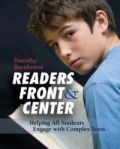 I just finished reading a new book and now I’m feeling the need to shout about it. You might remember my posts from 2012 about my excitement after reading Barnhouse and Vinton’s What Readers Really Do from Heinemann (click on the 3 highlights and you will go to my past posts.) Dorothy Barnhouse has continued to share her work with her latest book, Readers Front and Center, from Stenhouse. Her premise is that “instead of listening for answers, we should be trying to listen to our students.” And she does exactly that as she takes us with her to each student she confers with. She believes that if we really listen to our students we will be able to figure out not only what they are comprehending but also how they are understanding or misunderstanding what they are reading. But the biggest thing I’ve learned from her is what to do once I make those discoveries.
I just finished reading a new book and now I’m feeling the need to shout about it. You might remember my posts from 2012 about my excitement after reading Barnhouse and Vinton’s What Readers Really Do from Heinemann (click on the 3 highlights and you will go to my past posts.) Dorothy Barnhouse has continued to share her work with her latest book, Readers Front and Center, from Stenhouse. Her premise is that “instead of listening for answers, we should be trying to listen to our students.” And she does exactly that as she takes us with her to each student she confers with. She believes that if we really listen to our students we will be able to figure out not only what they are comprehending but also how they are understanding or misunderstanding what they are reading. But the biggest thing I’ve learned from her is what to do once I make those discoveries.
In every conference that Barnhouse shares, you will notice how she situates the child as a problem solver. Too often when teachers find out that a child is confused, misunderstanding, or losing track of the characters or plot, the teacher jumps in to rescue the child. We show the child where he got confused and then prompt, nudge, or support him in finding the meaning we were hoping for (sometimes just giving the answer.) To this, Barnhouse says, “If we short-circuit our students’ thinking, they will fail to learn that reading is an intellectual enterprise” (p. 39.) If we want kids to be problem solvers as readers, then we have to expect that they will get confused and make errors.
Here are just a few gems from her book:
* She teaches us how to help students do the “back and forth work” that readers really do as their reading processing system is at work.
* She suggests using “and” instead of “but.” When we say “you did it over here, but you didn’t do it here,” we are emphasizing what the child got wrong. But when we say, “you did it here and you can also do it over here,” we believe the child can be successful. “If we treat students like meaning makers, they will act like meaning makers” (p. 148.)
* “A conference is not a delivery system for a teaching point” (p. 62.) It is a teachable moment.
* She encourages students to “think across the pages” — connecting details and then asking and answering their own why questions. She is building on the ideas we learned from her first book with Vinton, but you will have many new “aha” moments when reading these very specific scenarios and seeing how she works with students on Book/Brain charts.
* Her examples span grades 2-8 and also show how this teaching can work in individual conferences, with small groups, and with whole group teaching.
I learned so much from this text; my end pages are full of notes! I can’t wait to find a group of literacy friends to discuss this book with. (And you can still preview the book on-line for free at stenhouse.com.)
Thanks so much for sharing this, Pat! It sounds like a book I will have to read, and reminds me very much of the ideas found in Peter Johnston’s Opening Minds.
Yes, Rose, she quotes Peter Johnston’s work a lot, as do I in all my workshops. All good stuff to keep us thinking.
Hi Pat,
Wow, this sounds like a book all parents and teachers of early – emergent readers should read before we read with our children. I know I have done the “but” comment, especially with my third child due to my impatience or inability to help her to read and comprehend. I should have allowed her to develop in her way as now she does not enjoy doing reading time with me. I wish I had this type of book or this book when she was younger. I look forward to reading this book and in the meantime will practice just listening to my reader! I hope you don’t mind I would like to share your blog in mine (Children Love Reading) so as to spread this knowledge as then others may not make the same mistakes that I have. I can’t wait to read this book now.
Michelle
Thanks for commenting, Michelle. I’m sure you will learn a lot from this book!
Reblogged this on Children love Reading and commented:
A great synopsis of a valuable book which seems to give us tools to help our children not only to read but to understand their comprehension when reading. Whether they understood or misunderstood when reading. I am about to start reading this as I need to assist my 10 year old rather than tell her. Great blog to follow! Michelle